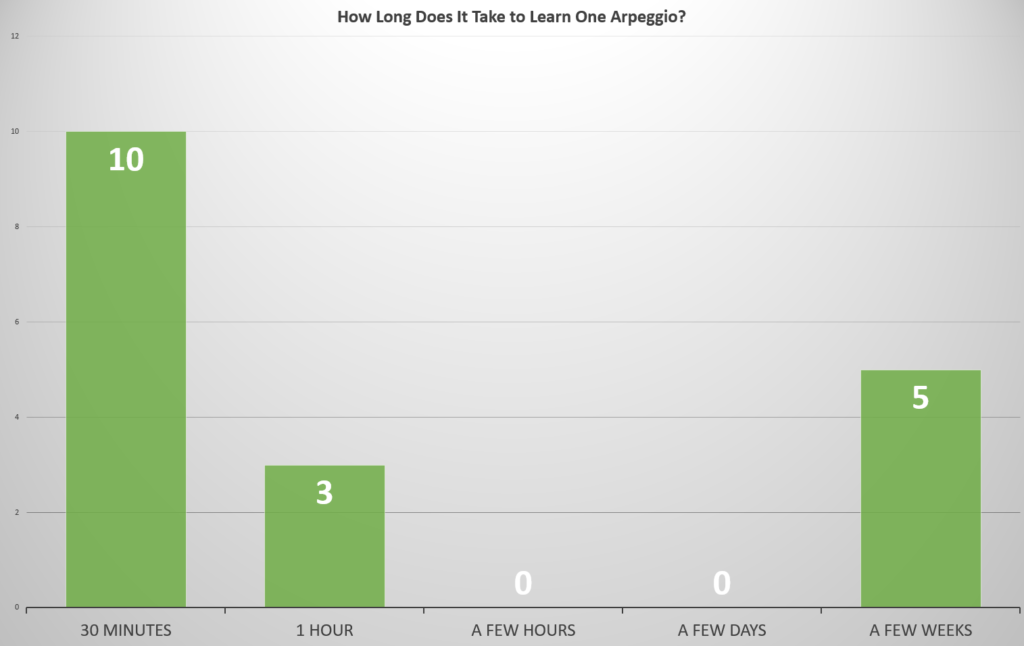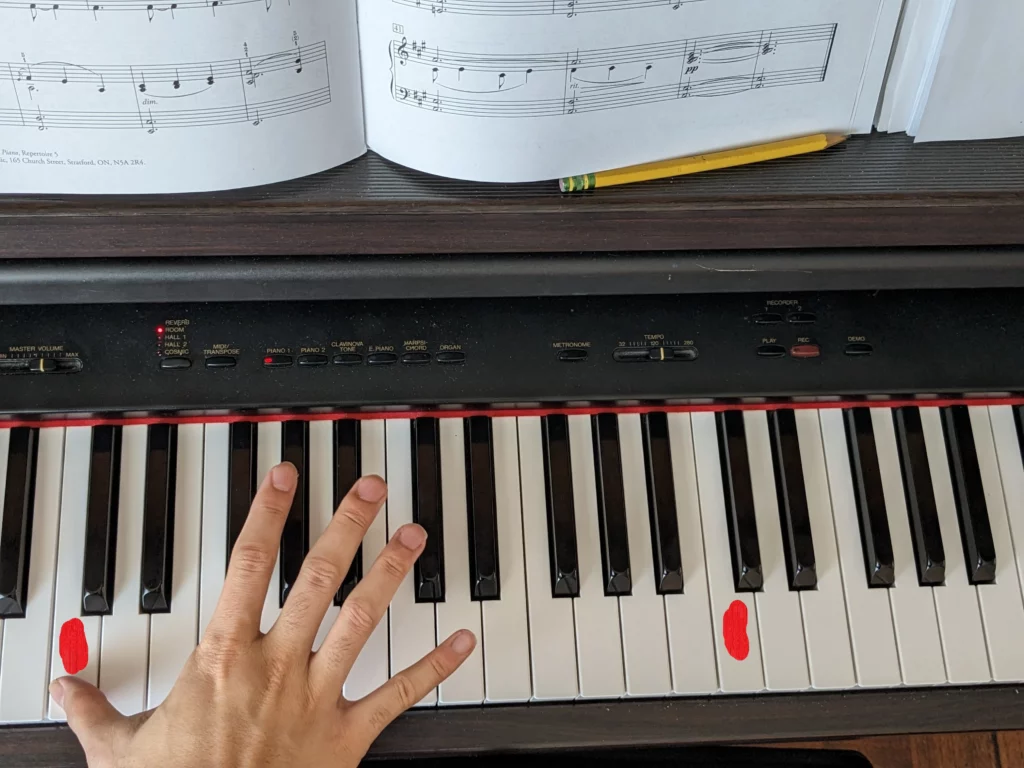This post contains affiliate links.
Today’s question is: “How long does it take to learn piano arpeggios”? Many have this question to see if it’s worth the time and effort. They may also want to know if they can fit it into their busy schedules.
It takes 30 minutes to a few weeks to learn and be comfortable playing a new arpeggio with both hands in two octaves, depending on many factors. However, with many different types of arpeggios and ways to practice them, it can take years to be proficient at piano arpeggios.
Continue reading as I share the results of a poll I conducted on how long people take to learn one arpeggio. I’ll also discuss the factors that affect how long it takes to learn arpeggios and share some tips for learning.
Interesting poll results
So I held a Facebook poll on how long it takes to play an arpeggio comfortably. Here are the results:

As we can see, most people say they need 1 hour or less to learn an arpeggio, while the rest say they need a few weeks to do the same.
Interestingly, some people need that long to learn one arpeggio. I clearly asked how much time they need to play one new arpeggio, two hands, and two octaves, so I’m quite surprised with this result. If you can think of why, email me the Contact Us option at the bottom of the page and let me know!
What is an arpeggio?
An arpeggio is played one note at a time to remind anyone who has forgotten what an arpeggio is. It consists of 3 notes from its respective scale: the root (1st), the 3rd, and the 5th. Taking the example of E Major, its arpeggio is E G# B.
How long does it take to learn piano arpeggios?
Learn one arpeggio
Playing one arpeggio with both hands and two octaves at a slow tempo should take one hour or less. If it’s your first time playing arpeggio, you’ll need more time than usual because arpeggios are tricky to play accurately. Every arpeggio requires you to tuck your thumb to reach the next note because it’s too far away, which feels awkward if you’re not used to it.
Note that the one-hour mark is only an estimate, and each person needs a different amount of time to learn arpeggios, depending on many factors. That’s why some learn quicker than others.
How quickly you can learn one arpeggio depends mainly on how much time you spend practicing arpeggio. The more time you spend, the quicker you will learn arpeggios. However, you don’t want to spend too much time practicing, or you’ll get burnt out. 10-15 minutes daily practicing arpeggios (and scales) is more than enough.

Aside from how long you practice, three other factors determine how quickly you learn arpeggios:
Some arpeggios are harder than others: arpeggios like B major are trickier to play because it has two black keys. As black keys are thinner, slipping and missing is easier, especially when played at a high tempo. Another example is the C sharp major arpeggio which has a trickier thumb tuck than other arpeggios.
Fortunately, the difficult arpeggios are only slightly more difficult than other arpeggios. You only need to spend a bit more time learning to play them accurately.
Many arpeggios have the same fingerings. This means the more arpeggios you know and the more experience you have practicing them, the easier and quicker it is to learn new arpeggios.
How fast do you want to go? Learning to play arpeggios at a slow tempo is easy. However, it gets harder as the tempo increases. The faster you play, the easier it is to make mistakes. Ideally, you should aim to be able to play at 92 BPM, four notes every beat. This is the requirement for RCM Level 10.
Learn all arpeggios
Learning one arpeggio is quick, but the same can’t be said for learning all arpeggios. There are so many types of arpeggios out there (major, minor, dominant 7th, diminished, augmented, etc.) and ways to practice them (staccato, legato, off-beat, inversions). You’ll need at least a few years to learn them all, especially if you want to play them at a high tempo.
For this reason, learning all arpeggios should be a secondary goal. The main goal of learning and practicing arpeggios is to improve your fingers’ accuracy and speed.
Why learning arpeggios is worth it
If you’re serious about playing the piano, learning arpeggios is always worth it, regardless of how long it takes.
One of the biggest benefits of practicing arpeggios is to increase your speed and accuracy on the piano. Those thumb tucks from arpeggios will train your fingers to play the correct notes every time.
Also, the more arpeggios you know, the easier it is to learn new pieces. This is because arpeggios show up a lot in piano pieces. By recognizing them, you’ll be learning the piece a lot faster.
Aside from these two main benefits, practicing arpeggios also offers you many more benefits. Check out this article, where I discuss how practicing arpeggios can improve your music skills and techniques.
Tips for learning arpeggios
1. Practice slowly first
When practicing arpeggios, accuracy is always more important than speed. Being able to play an arpeggio quickly doesn’t matter if you can’t play it right.
So when you learn a new arpeggio, set your metronome to a slow tempo, like 60. Once you can play it comfortably without stiffening your fingers, raise the tempo bit by bit. I recommend raising the tempo by 5 each time.
If you still make mistakes even at a slow tempo, go even slower. Go as slowly as possible until you can play the arpeggio right.
If you haven’t gotten a metronome yet, this is your sign to get one. A metronome is an essential tool that every musician must own. It’s like how a mechanic can’t work without a hammer.
2. Learn with the respective scale
When you learn a new scale, also learn its arpeggio to hit two birds with one stone. By learning them as a combo, you will remember them better as you associate them.
3. Start by learning easy arpeggios
This one is a no-brainer. If you are a beginner, learn easy arpeggios before moving on to harder ones.
The easiest arpeggio to learn is the C Major arpeggio because it has no black keys. Therefore, it’s pretty straightforward to play it. The notes are C E G. Here’s how to play it:
Once you finish learning the C Major arpeggio, check out this article to know which scales and arpeggios to learn next.
4. Create a habit of practicing
Let’s be honest; practicing scales and arpeggios is dull for many people. I recommend practicing your scales and arpeggios for 5-10 minutes of your practice session. Doing this will quickly get them out of your way and warm up your fingers.
Of course, if you enjoy practicing arpeggios, go ham and practice away! The more you practice, the more benefits you’ll reap from it. Just be careful not to get burnout from practicing too much.
You may also want to read
Piano players also practice scales for the same reasons they practice arpeggios. Ever wondered how long learning a scale takes? Check out this article.

